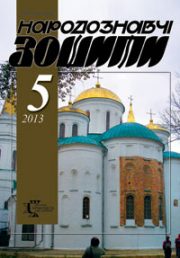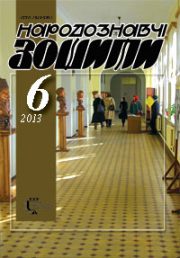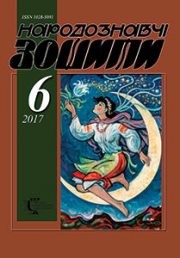The Ethnology Notebooks. 2022. № 6 (168), 1332—1349
UDK 392:[728.6:[644.36:628.9.04]](477:292.452)”18/19″
DOI https://doi.org/10.15407/nz2022.06.1332
SYVAK Vasyl
- ORCID ID: https:/ /orcid.org/0000-0002-6444-0705
- Ph.D. of Sciences in History,
- research worker in the department of the Historical Ethnology
- of the Institute of Ethnology
- of National Academy of Sciences of Ukraine,
- 15, Svobody Avenue, 79000, Lviv, Ukraine,
- Contacts: e-mail: suvakvasul@gmail.com
Abstract. Fire, water, earth, air belong to one of the main components of the structure of earthly life. We consider fire in several planes, from one it brings death, incinerates everything that happens in its path, and from the other it gives light and heat, and therefore life and existence on the planet.
The study of hand-made fire based illumination, which was used, with different intensity, by the Ukrainians of the Carpathians, as well as by residents of other ethnographic regions and districts of Ukraine (according to the current zoning in the late 19th — the first half of the 20th century), to this day it is relevant for Ukrainian ethnographic science. The purpose of the research is to collect, analyze, systematize available source, archival and published materials of researchers of different periods on the researched topic. The object of the study is the means and devices for obtaining fire, and the subject is various materials for kindling and maintaining fire, methods of obtaining, beliefs and customs related to the cult of obtained «alive» fire. The general scientific principles of historicism, systematicity, and scientific objectivity became the methodological basis of the research, which made it possible to carry out the necessary scientific analysis of the researched topic in general, as well as its individual aspects. To date, the specified problem has not been a separate object of research. The territory of the study covers three ethnographic districts of the Ukrainian Carpathians — Boikivshchyna, Hutsulshchyna and Lemkivshchyna. For a broader comparative base, materials from the published works of Ukrainian researchers representing other ethnographic regions and districts of Ukraine, as well as the works of foreign scientists, were used. The chronological boundaries of the study cover the end of the 19th the first half of the 20th century. The source base was formed with the help of stationary and route ethnographic expeditions, during which field materials were recorded using photography, measurements, sketches, and oral interviews of respondents, so a significant part of the work is the author’s field materials.
Primitive devices and methods of obtaining fire and materials for arson were often used by Ukrainian highlanders throughout their lives, regardless of the type of housing and the duration of centuries, which is characteristic of the entire ethnic territory of Ukraine. Along with this, in the context of our study, certain devices, fire-making methods, beliefs and customs associated with the cult of fire bear local specificity, which is characteristic only for each of the ethnographic groups of the Ukrainian Carpathians — Boikos, Lemkos and Hutsuls.
Keywords: Ukrainian Carpathians, Boikos, Lemkos and Hutsuls, fire, devices, means, methods, materials for arson.
Received 18.11.2022
REFERENCES
- Hoshko, Y.G. (1976). The population of the Ukrainian Carpathians of the 15th—18th centuries. Settlement. Migration Everyday life. Kiev: Scientific Opinion [in Ukrainian].
- Shyvelbush, V. (2014). Enchanted night. To the history of artificial light in the 19th century [in Ukrainian].
- Seheda, S. (2009). Anthropology. Textbook for students of humanitarian specialties of higher educational institutions [in Ukrainian].
- Tyvodar, M. (1994). Traditional cattle breeding of the Ukrainian Carpathians in the second half of the 19th — the first half of the 20th century. Historical and ethnological research [in Ukrainian].
- Shukhevych, V. (2018). Hutsulshchyna: in 5 parts [in Ukrainian].
- Moszynski, K. (1919). Kultura ludowa slowian. Cz. 1: Kultura materialna [in Polish].
- Holubiec, J.W. (1990). Polskie lampy i swieczniki [in Polish].
- History of Ukraine. (1996). Osmomysl. Lviv. No. 1.5 [in Ukrainian].
- Matyushin, H. (1972). In the cradle of history [in Russian].
- Falkovskyi, Ya. (1935). Village of Volosate, Lisky district. Chronicle of Boikivshchyna (Part 5, year V, pp. 14—28) [in Ukrainian].
- Syvak, V. (2007). Kresalo. A small encyclopedia of Ukrainian ethnology (Pp. 291—292) [in Ukrainian].
- Niderle, L. (1956). Slavic antiquities [in Russian].
- Bonkovska, S. (1991). Blacksmithing in Ukraine (XIX — beginning of XX centuries) [in Ukrainian].
- Falkowski, J. (1937). Zachodnie pogranicze Huculszczyzny: Dolinami Prutu, Bystrycy Nadwornianskiej, Bystrycy Soltwinskiej i Lomnicy [in Polish].
- Archive of Institute of Ethnology of NASU (hereinafter — Archive of IE NASU). F. 1. Op. 2. Unit. coll. 364. Ethnographic field materials on the topic «Interior of folk dwelling», collected by V.P. Syvak in the Ivano-Frankivsk region in 1990. 63 sheets [in Ukrainian].
- Shevchenko, Ye. (2009; 2010). Dictionary of folk terminology. Folk art. To the 360th anniversary of the formation of the Cossack state. 2009. No. 3—4; 2010. No. 1—2 [in Ukrainian].
- Kotyhoroshko, V. (2008). Upper Potyssia at ancient times. 1,000,000 years ago — 10th century AD. [in Ukrainian].
- Syvak, V. (2003). The interior of a Polissia dwelling. Polissia of Ukraine: materials of historical and ethnographic research. Vol. 3. In the confluence of the Uzh and Teteriv rivers. 1996. pp. 125—166 [in Ukrainian].
- Zaikolsky, E. (1989). Sponge. Ethnography of Belarus. Encyclopedia. P. 161 [in Belarusian].
- Archive of IE NASU. F. 1. Op. 2. Unit of collection 402. Ethnographic field materials on the topic «Interior of folk dwellings», collected by V.P. Syvak in Skolivskyi, Turkivskyi districts of the Lviv region. and Volovetskyi, Mizhhirskyi districts of the Zakarpattia region. in 1994 73 sheets [in Ukrainian].
- Falkowski, J. (1938). Polnocno-wschodnie pogranicze Huculszczyzny [in Polish].
- Kravchenko, V. (1927). Fire. The material was collected on the Right Bank. Primitive citizenship and its remnants in Ukraine (Issue 1—3, p. 159) [in Ukrainian].
- Archive of IE NASU. F. 1. Op. 2. Unit. coll. 367. Zosh. 3. Ethnographic field materials on the topic «Interior of folk dwelling», collected by V.P. Syvak in the Horodenkiv district of the Ivano-Frankivsk region. in 1997. 87 sheets [in Ukrainian].
- Skurativskyi, V.(1988). Posvit. Fiction stories, short stories [in Ukrainian].
- Balushok, V. (1993). The world of the Middle Ages in the rituals of Ukrainian guild craftsmen [in Ukrainian].
- Archive of IE NASU. F. 1. Op. 2. Unit. coll. 359. Zosh. 1. Field ethnographic materials on the topic «Interior of folk dwelling», collected by V.P. Syvak in the Starosambir district of the Lviv region in 1989. 65 sheets [in Ukrainian].
- Archive of IE NASU. F. 1. Op. 2. Unit. coll. 332. Ethnographic field materials on the topic «Interior of folk dwelling», collected by V.P. Syvak in Dolynsky district, Ivano-Frankivsk region in 1986. 82 sheets [in Ukrainian].
- Radovych, R. (2018). The development of the heating system for the housing of Ukrainians in the Carpathians. Fortress. Collection of the Tustan reserve. Book 3. Space (Pp. 401—405) [in Ukrainian].
- Sopolyha, M. (2016). Folk architecture of Ukrainians in Slovakia [in Ukrainian].
- Reinfuss, R. (1977). Meblarstwo ludowe w Polsce [in Polish].
- Shulhina, L. (1929). Lighting devices in the village Bubnivtsi in Podillia. Materials for ethnology (Vol. II, pp. 52—65) [in Ukrainian].
- Kaindl, R.F. (2000). Hutsuls: their life, customs and folk tales [in Ukrainian].
- Mandybura, M. (1978). The mountain meadow economy of the Hutsul region in the second half of the 19th — 30s of the 20th century [in Ukrainian].
- Slavic antiquities. (2012). Ethnolinguistic dictionary: in 5 volumes [in Russian].
- Voropai, O. (1958). Customs of our people. Ethnographic essay (Vol. I) [in Ukrainian].
- (2012). 100 most famous images of Ukrainian mythology [in Ukrainian].
- Marutian, A. (1989). The interior of the Armenian folk dwelling (second half of the 19th — beginning of the 20th century. Armenian ethnography and folklore: materials and researches (Vol. 17, p. 93) [in Russian].







